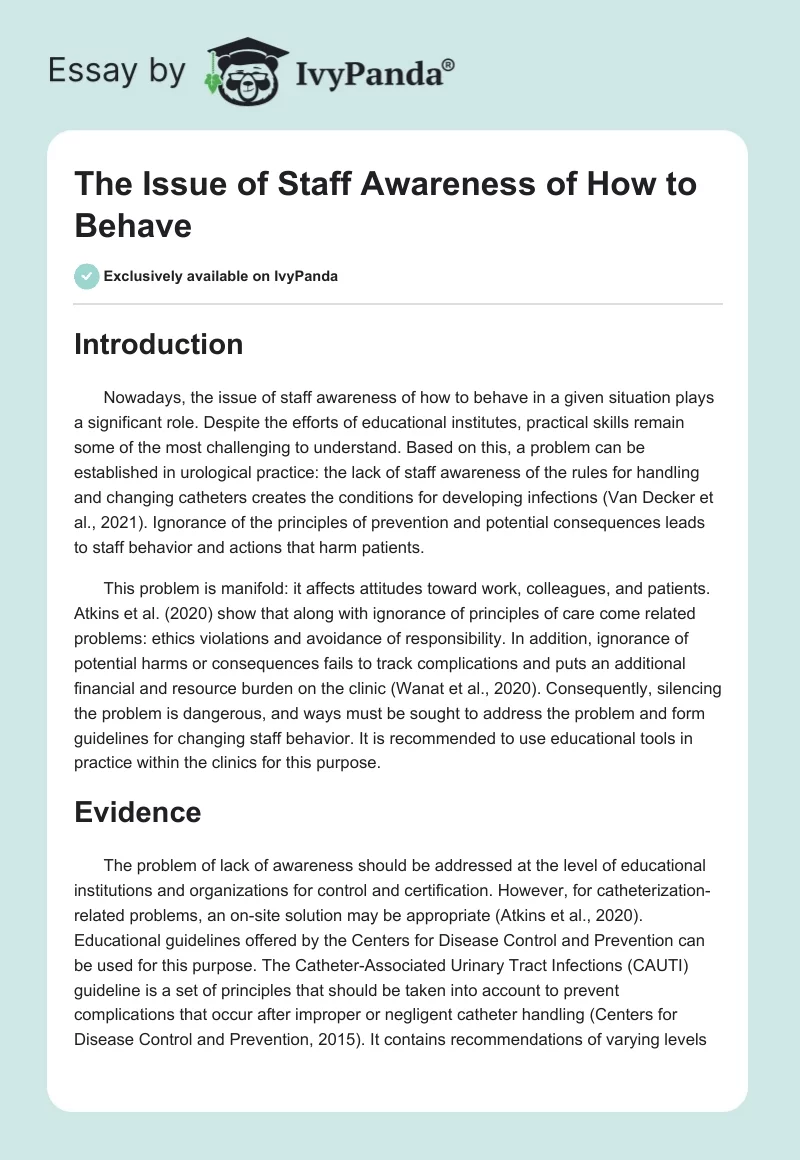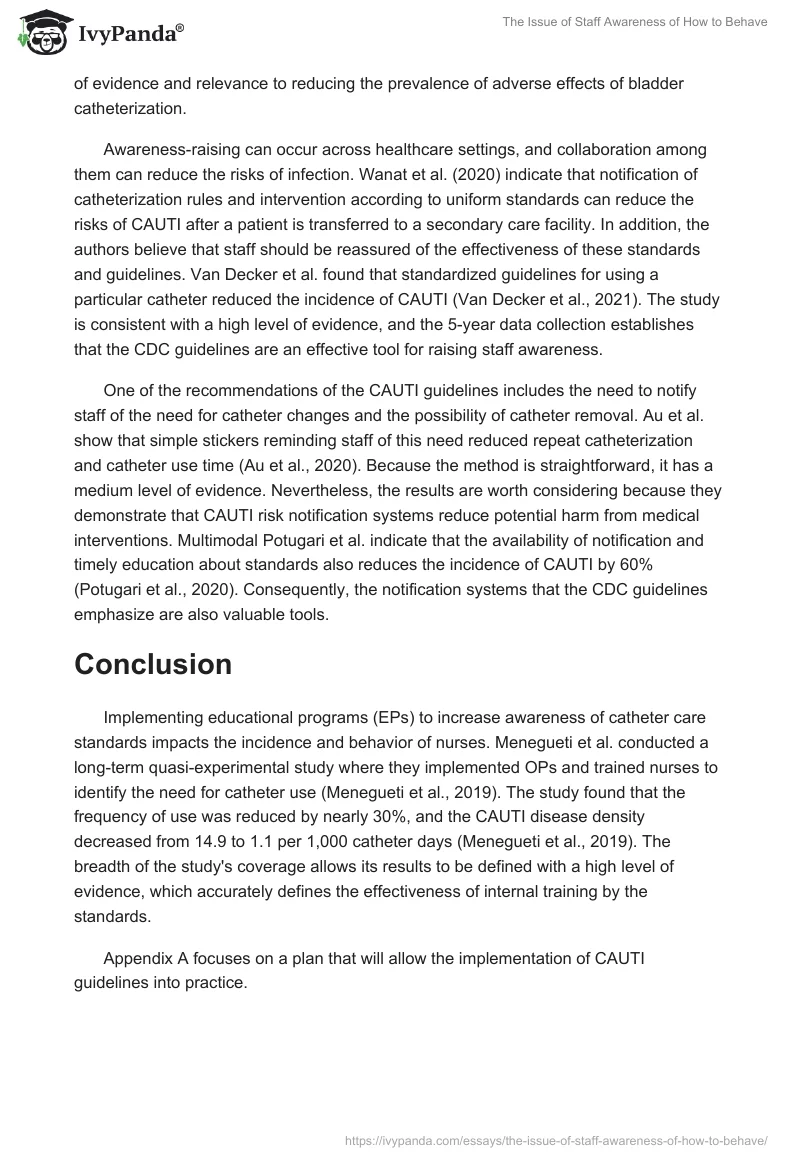Introduction
Nowadays, the issue of staff awareness of how to behave in a given situation plays a significant role. Despite the efforts of educational institutes, practical skills remain some of the most challenging to understand. Based on this, a problem can be established in urological practice: the lack of staff awareness of the rules for handling and changing catheters creates the conditions for developing infections (Van Decker et al., 2021). Ignorance of the principles of prevention and potential consequences leads to staff behavior and actions that harm patients.
This problem is manifold: it affects attitudes toward work, colleagues, and patients. Atkins et al. (2020) show that along with ignorance of principles of care come related problems: ethics violations and avoidance of responsibility. In addition, ignorance of potential harms or consequences fails to track complications and puts an additional financial and resource burden on the clinic (Wanat et al., 2020). Consequently, silencing the problem is dangerous, and ways must be sought to address the problem and form guidelines for changing staff behavior. It is recommended to use educational tools in practice within the clinics for this purpose.
Evidence
The problem of lack of awareness should be addressed at the level of educational institutions and organizations for control and certification. However, for catheterization-related problems, an on-site solution may be appropriate (Atkins et al., 2020). Educational guidelines offered by the Centers for Disease Control and Prevention can be used for this purpose. The Catheter-Associated Urinary Tract Infections (CAUTI) guideline is a set of principles that should be taken into account to prevent complications that occur after improper or negligent catheter handling (Centers for Disease Control and Prevention, 2015). It contains recommendations of varying levels of evidence and relevance to reducing the prevalence of adverse effects of bladder catheterization.
Awareness-raising can occur across healthcare settings, and collaboration among them can reduce the risks of infection. Wanat et al. (2020) indicate that notification of catheterization rules and intervention according to uniform standards can reduce the risks of CAUTI after a patient is transferred to a secondary care facility. In addition, the authors believe that staff should be reassured of the effectiveness of these standards and guidelines. Van Decker et al. found that standardized guidelines for using a particular catheter reduced the incidence of CAUTI (Van Decker et al., 2021). The study is consistent with a high level of evidence, and the 5-year data collection establishes that the CDC guidelines are an effective tool for raising staff awareness.
One of the recommendations of the CAUTI guidelines includes the need to notify staff of the need for catheter changes and the possibility of catheter removal. Au et al. show that simple stickers reminding staff of this need reduced repeat catheterization and catheter use time (Au et al., 2020). Because the method is straightforward, it has a medium level of evidence. Nevertheless, the results are worth considering because they demonstrate that CAUTI risk notification systems reduce potential harm from medical interventions. Multimodal Potugari et al. indicate that the availability of notification and timely education about standards also reduces the incidence of CAUTI by 60% (Potugari et al., 2020). Consequently, the notification systems that the CDC guidelines emphasize are also valuable tools.
Conclusion
Implementing educational programs (EPs) to increase awareness of catheter care standards impacts the incidence and behavior of nurses. Menegueti et al. conducted a long-term quasi-experimental study where they implemented OPs and trained nurses to identify the need for catheter use (Menegueti et al., 2019). The study found that the frequency of use was reduced by nearly 30%, and the CAUTI disease density decreased from 14.9 to 1.1 per 1,000 catheter days (Menegueti et al., 2019). The breadth of the study’s coverage allows its results to be defined with a high level of evidence, which accurately defines the effectiveness of internal training by the standards.
Table 1 focuses on a plan that will allow the implementation of CAUTI guidelines into practice.
Table 1. PDSA Cycle Worksheet
References
Atkins, L., Sallis, A., Chadborn, T., Shaw, K., Schneider, A., Hopkins, S., Bunten, A., Michie, S., & Lorencatto, F. (2020). Reducing catheter-associated urinary tract infections: a systematic review of barriers and facilitators and strategic behavioral analysis of interventions.Implementation Science: IS, 15(1), 44. Web.
Au, A. G., Shurraw, S., Hoang, H., Wang, S., & Wang, X. (2020). Effectiveness of a simple intervention for prevention of catheter-associated urinary tract infections on a medical hospital unit.Journal of Infection Prevention, 21(6), 221–227. Web.
Centers of Disease Control and Prevention. (2015). Catheter-Associated Urinary Tract Infections (CAUTI). CDC. Web.
Menegueti, M. G., Ciol, M. A., Bellissimo-Rodrigues, F., Auxiliadora-Martins, M., Gaspar, G. G., Canini, S., Basile-Filho, A., & Laus, A. M. (2019). Long-term prevention of catheter-associated urinary tract infections among critically ill patients through the implementation of an educational program and a daily checklist for maintenance of indwelling urinary catheters: A quasi-experimental study.Medicine, 98(8), e14417. Web.
Potugari, B. R., Umukoro, P. E., & Vedre, J. G. (2020). Multimodal intervention approach reduces catheter-associated urinary tract infections in a rural tertiary care center.Clinical Medicine & Research, 18(4), 140–144. Web.
Van Decker, S. G., Bosch, N., & Murphy, J. (2021). Catheter-associated urinary tract infection reduction in critical care units: a bundled care model. BMJ Open Quality, 10(4), e001534. Web.
Wanat, M., Borek, A. J., Atkins, L., Sallis, A., Ashiru-Oredope, D., Beech, E., Butler, C. C., Chadborn, T., Hopkins, S., Jones, L., McNulty, C., Roberts, N., Shaw, K., Taborn, E., & Tonkin-Crine, S. (2020). Optimizing interventions for catheter-associated urinary tract infections (CAUTI) in primary, secondary, and care home settings.Antibiotics (Basel, Switzerland), 9(7), 419. Web.


